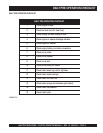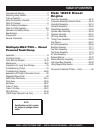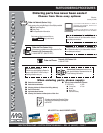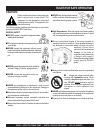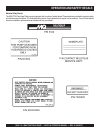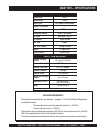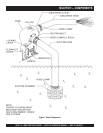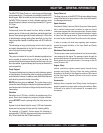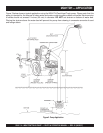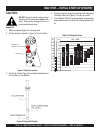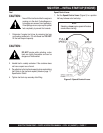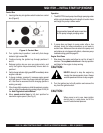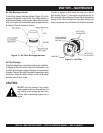
MQ41TDH TRASH PUMP — PARTS & OPERATION MANUAL — REV. #3 (04/02/07) — PAGE 13
MQ41TDH — GENERAL INFORMATION
The MQ41TDH Trash Pump is a self-priming centrifugal trash
pump powered by a 15 horsepower air-cooled four stroke HATZ
diesel engine. Both the intake (suction) and discharge ports on
the MQ41TDH incorporate a 4-inch diameter opening, which
allows the pump to pump at a rate of approximately 611 gpm or
2,313 lpm.
Trash Pump
Trash pumps derive their name from their ability to handle a
greater amount of debris and solids than standard centrifugal
pumps. These pumps generally handle solids up to 1/2 the size
of the discharge opening making them less likely to clog. Also
trash pumps are capable of handling water with 25% solids by
weight.
The advantage of using a trash pump is that it can be quickly
and easily disassembled in the field to remove debris in the
event the pump becomes clogged.
Suction Lift
This pump is intended to be used for dewatering applications
and is capable of suction lifts up to 25 feet at sea level. For
optimal suction lift performance keep the suction hose or line as
short as possible. In general always put the pump as close to the
water as possible.
Pump Support
The pump should always be placed on solid stationary ground
in a level position. To prevent the trailer from tipping, place blocks
under the trailer's bumper. In addition, place chock blocks behined
each wheel to prevent the trailer from rolling.
NEVER place the pump on
soft soil
. The suction hose or pipe
connection should always be checked for tightness and leaks. A
small suction leak in the hose or fittings could prevent the pump
from priming.
Elevation
Elevations over 3,000 feet will effect the performance of the
pump. Due to less atmospheric pressure at higher altitudes,
pumps DO NOT have the priming ability that they have at sea
level.
A general rule of thumb is that for every 1,000 feet of elevation
above sea level a pump will lose one foot of priming ability.
For example, in Flagstaff, Arizona where the elevation is
approximately 7,000 feet, the pump would have a suction lift of
only 18 feet rather than the 25 feet at sea level.
Pump Clean-out
The clean-out cover on the MQ41TDH has been design for easy
removal that allows for easy access to the volute and impeller
for cleaning and servicing.
Spark Arresters
State Health Safety Codes and Public Resources Codes specify
that in certain locations spark arresters be used on internal
combustion engines that use hydrocarbon fuels. A spark arrester
is a device designed to prevent accidental discharge of sparks
or flames from the engine exhaust. Spark arresters are qualified
and rated by the United States Forest Service for this purpose.
In order to comply with local laws regarding spark arresters,
consult the engine distributor or the
local Health and Safety
Administrator.
Mechanical Seal Lubrication
The pump uses a water-cooled mechanical seal to prevent water
from seeping into the engine. The passage of water through the
pump casing lubricates the seal and prevents it from overheating.
Never operate the pump without water in the casing as this will
cause the seal to fail.
Engine Safety
Internal combustion engines present special hazards during
operation and fueling! Failure to follow the safety guidelines
described in the Rules for Safe Operation section of this manual
and the Hatz Engine Operator's Manual could result in severe
injury or death.
Accessories
Multiquip offers a complete line of fittings, hoses, and clamps to
properly connect the pump to match various job conditions. Refer
to the part list in section 2 of this manual for a complete list of
accessories
.



